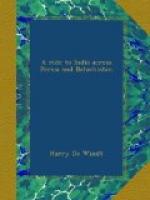The inhabitants of Baluchistan may be roughly divided into two classes: the Brahuis [A] in the north, and the Baluchis in the south. The former ascribe their origin to the earliest Mohammedan invaders of Persia, and boast of their Arab descent; the latter are supposed by some to have been originally a nation of Tartar mountaineers who settled at a very early period in the southern parts of Asia, where they led a nomad existence for many centuries, governed by their own chiefs and laws, till at length they became incorporated and attained their present footing at Kelat and throughout Northern Baluchistan. Both races differ essentially in language and customs, and are subdivided into an infinitesimal number of smaller tribes under the command or rule of petty chiefs or khans. Although somewhat similar in appearance, the Brahuis are said to be morally and physically superior to their southern neighbours. The Baluch, as I shall now call each, is not a prepossessing type of humanity on first acquaintance, with his swarthy sullen features, dark piercing eyes, and long matted locks. Most I met in the interior looked, a little distance off, like perambulating masses of dirty rags; but all, even the filthiest and most ragged, carried a bright, sharp tulwar. Though rough and uncouth, however, I found the natives, as a rule, hospitable and kindly. It was only in the far interior that any unpleasantness was experienced. This was, perhaps, only natural, seeing that seventy miles of the journey lay through a region as yet unexplored by Europeans, the inhabitants of which were naturally resentful of what they imagined to be intrusion and interference.
Owing to the nomadic nature of the Baluchis, the barrenness of their country, and consequent absence of manufactures and commerce, permanent settlements are very rare.
[Illustration: SONMIANI]
With the exception of Quetta, Kelat, Beila, and Kej, there are no towns in Baluchistan worthy of the name. Even those I have mentioned are, with the exception of Quetta (now a British settlement), mere collections of tumble-down mud huts, invariably guarded by a ramshackle fort and wall of the same material. The dwellings of the nomads consist of a number of long slender poles bent and inverted towards each other, over which are stretched slips of coarse fabrics of camel’s hair. It was only in the immediate neighbourhood of Gwarjak that the native huts were constructed of dried palm-leaves, the fertile soil of that district rendering this feasible.
Attended by Chengiz Khan in a gorgeous costume of blue and yellow silk, and followed by a rabble of two or three hundred men and boys, I visited the bazaar next morning. Chengiz had preceded his visit with the present of a fine goat, and evidently meant to be friendly, informing me, before we had gone many yards, that the Queen of England had just invested the Djam of Beila (a neighbouring chief) with the Star of India, and did I think that that honour was very likely to accrue to him?




